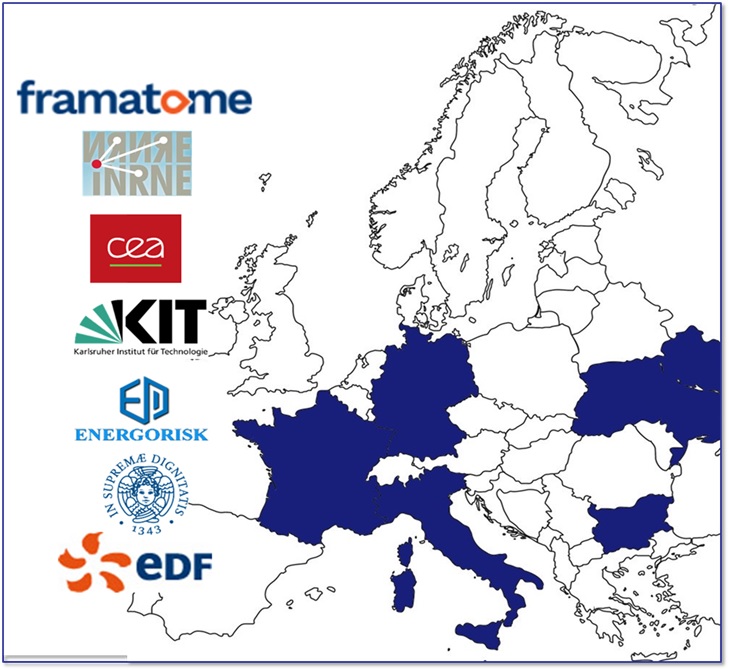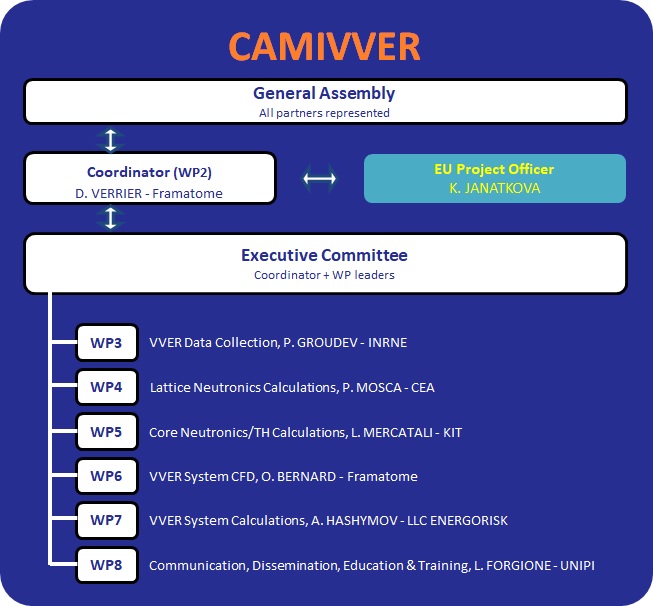CAMIVVER is a project funded by the European Commission, launched in
the framework of the Horizon 2020 research program. The project
started on the 1st of September 2020 for a duration of three years. The
total budget is € 3,988,547. The project is coordinated by Framatome in
France.
The project consortium consists of 7 partners from 5 countries involving
industry, research organizations and universities. They have a strong
safety culture, a strong experience on design and operation of Gen. II and
Gen. III reactors, on VVER safety analysis and on codes and methods
development and validation.

The European nuclear fleet is composed of Gen. II and Gen. III reactor types. This fleet is currently going through Long Term Operation
(LTO) upgrades and that remains an important concern for the European Community. As for reactor types it is composed of about 70%
of PWR type, the remaining part being covered by BWR, AGR and VVER types. VVER part is about 10% and therefore it constitutes a
non-negligible component of the European fleet; in particular for those countries that rely on VVER technology for their electricity
supply at present and as long term solution.
Several VVER reactor units are planned for construction – or are currently under construction – inside the EU (Slovakia, Hungary and
Finland) and in the neighboring countries (Ukraine, Turkey, Belarus, Russia), and Novovoronezh VVER plant (Russia) has proved that
VVER operational life can be extended up to 60 years. It is realistic to think that VVER type reactors will keep playing a strategic role for
the European energy and economic stability, its de-carbonation strategy, and the Europe safety in general. In this framework, the
Euratom Supply Agency (ESA) underlines as a matter of concern the 100% reliance on a single Russian supplier and therefore an issue
for all EU countries operating VVER reactors. Dependence on a single supplier constitutes a significant risk and qualifying an alternative
supplier could take several years because of licensing and testing requirements.
In order to support the development and the qualification of fuel and more generally to provide the required elements for the safety
analysis report (SAR), an important place is reserved to the development, improvement, verification and validation of codes and
methods used in the VVER safety analysis. The codes and methods continuous update needed for answering the regulatory
requirements for reactors LTO is the basis of CAMIVVER project proposal. These long term issues have initiated in 2020 the creation of
the CAMIVVER consortium for the improvement of codes and methods for VVER comprehensive safety assessment in support to other
activities carried out concerning VVER fuel development and qualification.
The project is oriented to VVER reactor type. However, due to some common issues associated to codes and methods development,
some activities have been extended to PWR needs (dominant part of the EU fleet).
PROJECT STRUCTURE
The project is organized in 7 Work Packages (WP). Each WP is dedicated to a specific part of the safety assessment calculation chain, except WP2 dedicated to Project Management, WP3 dedicated to VVER data collection and WP8 dedicated to Communication, Dissemination, Educational and Training activities. The project is driven by an Executive Committee and supervised by a General Assembly.

EXPECTED IMPACT
CAMIVVER promotes the use of multi-disciplinary deterministic methodologies to describe the interaction between thermal hydraulics and neutronics and the validation against high fidelity calculations such as Monte Carlo and CFD. CAMIVVER will improve the robustness and qualification level of the codes in the VVER scope. the robustness of the codes, currently used for western PWRs will be tested for the VVER type. CAMIVVER is based on new generation codes presently under continuous development.


